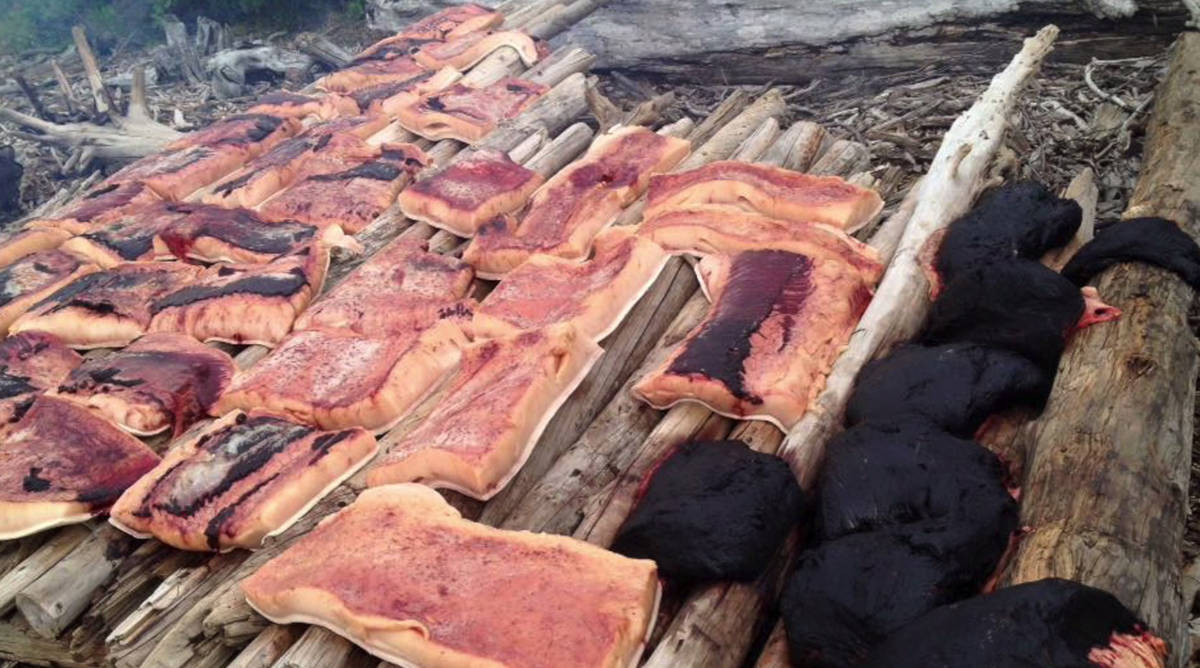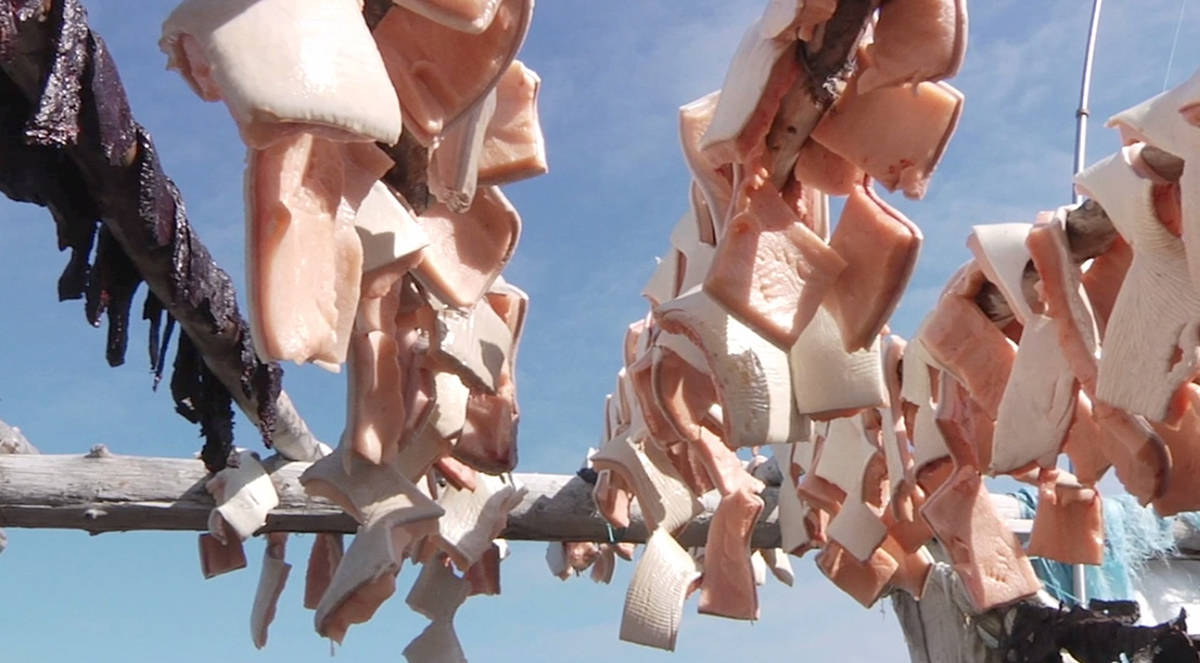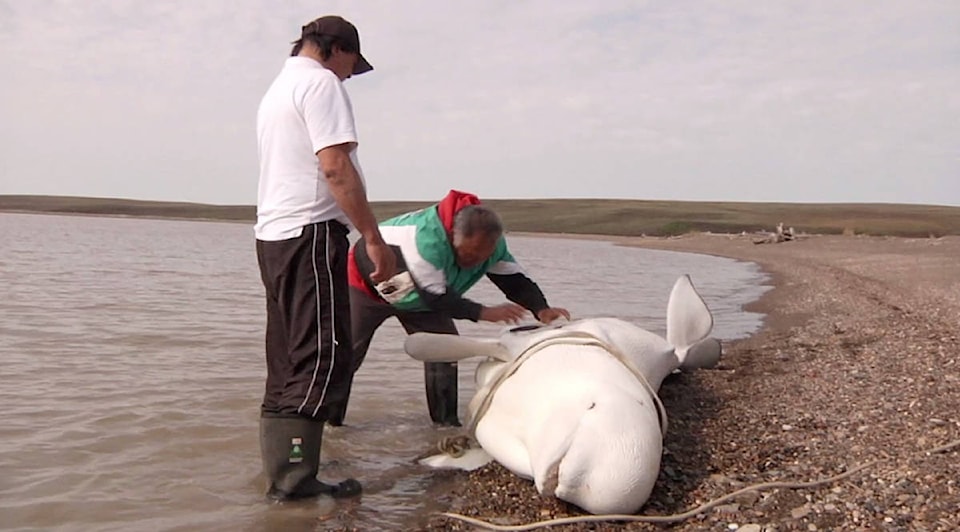When hunting a beluga whale, make sure to use a solid calibre of bullet and aim for the blowhole to ensure a quick and humane kill.
This and much more traditional Inuvialuit knowledge will soon be showcased in a documentary produced by the Joint Secretariat and the Inuvialuit Communications Society. The Beluga Harvest Youth Project shows the process hunting and harvesting the whales at Shingle Point on the northern tip of Yukon territory, as well as in camps around Inuvik, Tuktoyaktuk and Aklavik. The project was initiated by the Inuvialuit Game Council with funding through the Makeway foundation.
“Working with ICS, I learned a lot,” said producer and director Chukita Gruben, “But also the youth. ICS was making the film, mentoring and training youth and myself. But the youth created this documentary and did the rough cut.
“It was a lot of team building and flexibility. Seeing the youth grow was so amazing.”
Filmed and edited by Shinese Cockney, the documentary is a collection of interviews with longtime Beluga harvesters Dean Arey, Mary Ruth Meyook, Clara Day, Anthony and Frank Pokiak, Jim Elias about their experiences growing up with traditional practices. Hunters mix both modern and historical hunting tools, both with rifles and harpoons.
All the hunting footage in the documentary was taken from archives. No animals were harmed in the making of this documentary.
Hunting the whales is a traditional right of passage for both boys and girls, who are often snaring and hunting by age 12. Because the whales are so massive, the meat, called muktuk, is shared with the community.
”Beluga was always part of my diet,” said Elias. “I always go out there and harvest my muktuk for the winter, and that’s to pass on a tradition. When I let my son (Jesse) get his first whale, we gave it out — basically this whole beluga whale — to all the elders and people. Single parents and ones that couldn’t hunt.
“Part of the tradition back in those days. Where you get your first whale you give it out to the community. And that’s what I let Jesse do.”
As it is literally skin and fat, preparing muktuk safely is an art form in itself. Arey explains in the documentary that the meat needs to be dried out overnight. The top layer of blubber is removed and the meat is washed to remove any blood or other contaminants. The blubber is then cut into strips and left in a pale, where oil seeps out from the fat. The meat is then cooked at a very low temperature in water and simmered for at least two hours in the juices.
After its done cooking, the meat is laid out on logs so the water can drip out of it. Leftover blubber that is not used in making muktuk is used as insulation between layers of the delicacy. Essentially it acts to preserve the muktuk. The food is then frozen for special occasion and is often eaten right out of the freezer.
Muktuk isn’t the only food made from beluga meat. The back muscles are also hung out to dry and the bones are often carved into artwork.
However, cultural and climate pressures from a changing world have forced the tradition to adapt. This includes the size of the harvest itself, but also the location and how many people come out to camp.
Many of the Elders interviewed said the hunts are a shadow of how big of a gathering they used to be. Elias noted many youth don’t eat beluga as often anymore.
“I don’t kill as many whales as I used to,” said Elias. “The kids don’t hardly ever eat the muktuk now. Back in the 80s and 70s Tuktoyaktuk would usually get over 100 and some 140 whales basically a year. Now Tuk’s lucky to get maybe 40 or 50 on a high level. So our whales just declined quite a bit.”
Having such an intimate relationship with the whale, hunters have noticed significant changes in the behaviour of belugas as ice cover has receded. Elias notes the whales are calving earlier and many don’t have the thick layer of blubber they normally do.
This was Gruben’s first documentary project, and she said she’s learned a lot in the process. She said she wanted to share it around the schools.
Now that she’s gotten her first doc under her belt, Gruben said she’s not stopping anytime soon. She’s planning another project this summer to follow the research and collaboration between scientists and harvesters and show how the traditional practice helps improve scientific knowledge.’
The documentary will be available as part of a launch for the Beluga Project website, which will be a one-stop source for all information related to the beluga whale.


